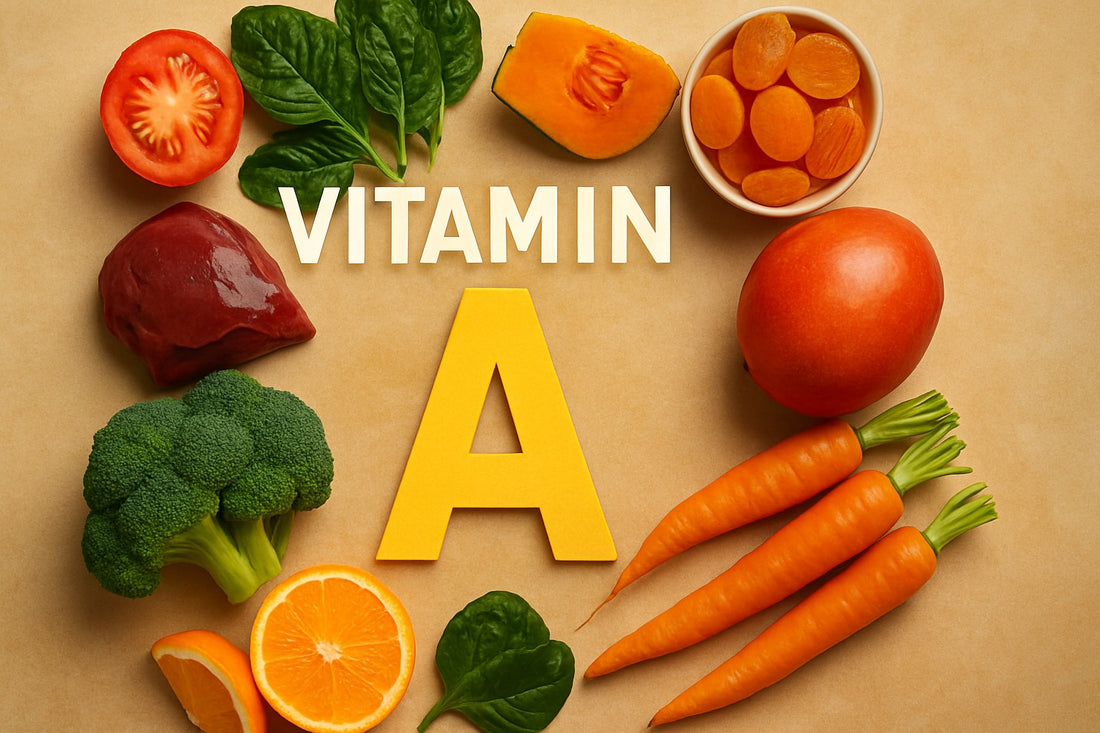
12 Best Vitamin A Foods to Boost Your Health in 2025
Share
In 2025, more people are realizing just how vital vitamin A foods are for a balanced, healthy diet. With so much focus on nutrition trends, vitamin A stands out for its impact on vision, immunity, and glowing skin.
Vitamin A is an essential nutrient that supports how we see, protects us from infections, and keeps our skin and cells functioning at their best. Yet, many still fall short of recommended intake.
This article explores the 12 best vitamin A foods to boost your health, using the latest nutrition science and straightforward tips. You will discover key benefits, deficiency risks, and practical ways to add these foods to your routine.
Are you ready to make smarter food choices for better health this year? Let’s get started.
Understanding Vitamin A: Types, Functions, and Daily Needs
Vitamin A is a vital nutrient that plays a critical role in maintaining our overall health. When discussing vitamin a foods, it is important to understand the different types of vitamin A, how our bodies use them, and the impact of daily intake. In 2025, awareness of vitamin a foods is growing as nutrition science continues to evolve.
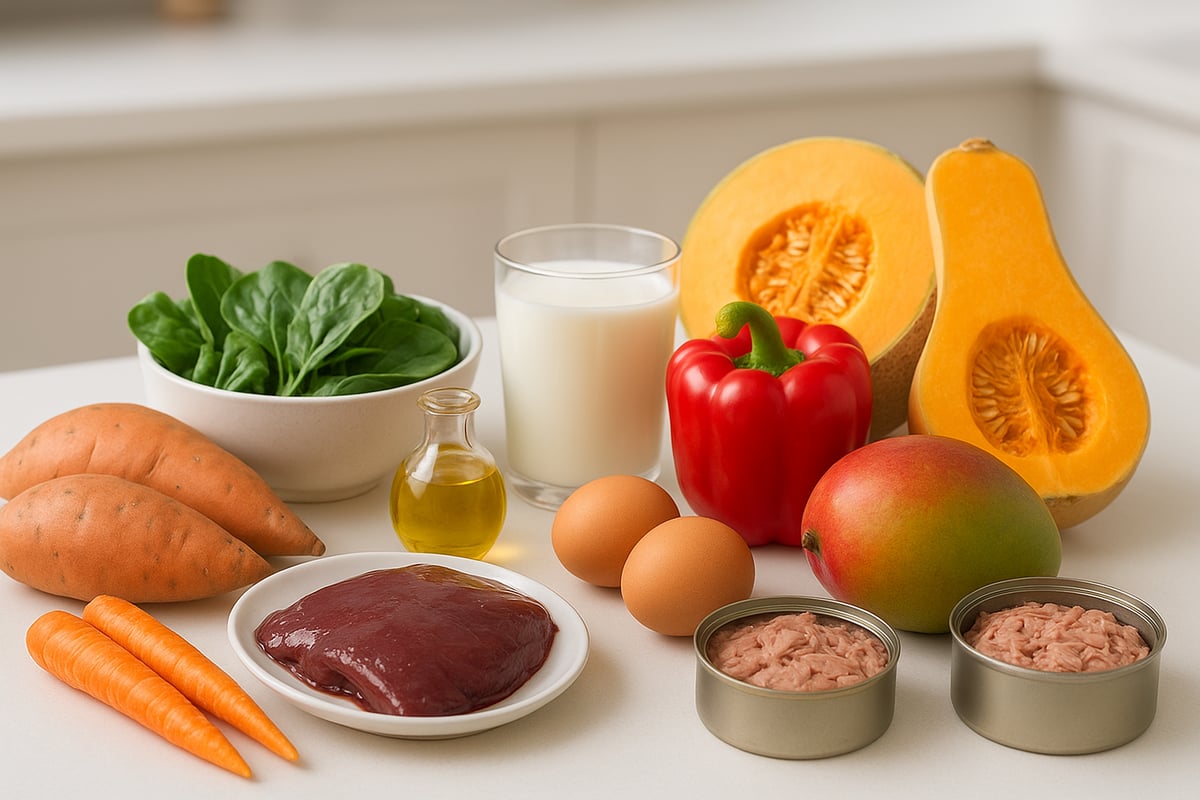
What Is Vitamin A?
Vitamin A is a fat-soluble vitamin essential for many bodily functions. It comes in two main forms: preformed vitamin A (retinol), found in animal products, and provitamin A carotenoids, like beta-carotene, found in plant foods. Animal sources deliver vitamin A in a form the body can use immediately, while plant sources require conversion. The absorption of retinol is typically more efficient than carotenoids, but both forms are crucial in a balanced diet. For an in-depth overview of vitamin A’s roles, sources, and health effects, refer to the Vitamin A and Carotenoids - Health Professional Fact Sheet. Including a variety of vitamin a foods ensures you benefit from both animal and plant forms.
Key Functions in the Body
Vitamin A contributes to several essential processes. It is best known for supporting vision, especially night vision, by forming components of the retina. This nutrient also helps regulate the immune system, making us more resilient to infections. Vitamin A plays a role in cellular growth, reproduction, and the maintenance of healthy skin. Carotenoids, a type of vitamin A found in many vitamin a foods, also act as antioxidants, protecting cells from damage caused by free radicals. These functions highlight why vitamin A is indispensable for daily health.
Recommended Daily Intake and Safety
The recommended dietary allowance (RDA) for vitamin A is 900 micrograms (mcg) for adult males and 700 mcg for adult females, according to the NIH in 2024. Food labels show the percentage of daily value (% DV) to help you track intake from vitamin a foods. It is important to note that vitamin A is fat-soluble, so excessive intake, especially from animal sources or supplements, can cause toxicity. The upper intake level is set to prevent adverse effects such as liver problems. Moderation and variety in vitamin a foods are key for safe consumption.
Signs of Deficiency and At-Risk Groups
A deficiency in vitamin A can lead to symptoms like night blindness, dry eyes, skin issues, and increased susceptibility to infections. Certain groups are more vulnerable, including people with malabsorption conditions such as celiac or Crohn’s disease, vegans who avoid animal products, and older adults with reduced nutrient absorption. While vitamin A deficiency is rare in developed countries like the US and Europe, it remains a significant concern in many parts of the world. Including a diverse range of vitamin a foods in your diet helps protect against deficiency and supports long-term wellness.
Health Benefits of Vitamin A-Rich Foods in 2025
Vitamin a foods continue to gain attention as research unveils their profound impact on overall health. From supporting sharp vision to strengthening immunity, these nutrient-dense options offer benefits that are both scientifically validated and increasingly relevant for modern lifestyles. In 2025, new trends and findings further highlight why vitamin a foods deserve a regular place on your plate.
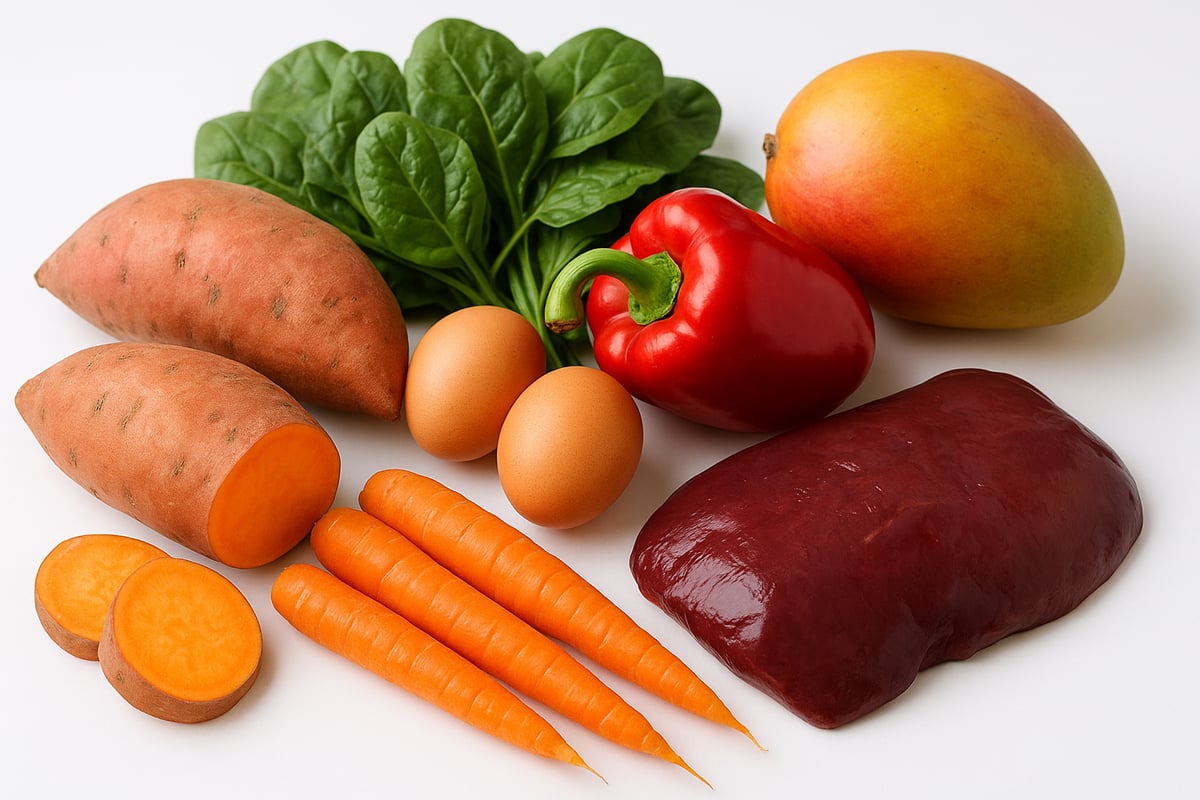
Vision and Eye Health
Vitamin a foods are essential for protecting and enhancing vision, especially night vision. Preformed vitamin A from animal sources, such as eggs and beef liver, and provitamin A carotenoids from plant foods like carrots and spinach, both play key roles in the retina's function. A deficiency can lead to night blindness or even more severe eye disorders.
Carotenoids, including lutein and zeaxanthin, offer additional protection against age-related macular degeneration, a leading cause of vision loss. According to EFSA-Approved Health Claims, these nutrients contribute to the maintenance of normal vision, underscoring the importance of vitamin a foods for eye health.
Immune System Support
Regularly eating vitamin a foods helps maintain robust immune defenses. Vitamin A supports the body’s mucous membranes, acting as a frontline barrier against bacteria and viruses. This function is vital for respiratory tract health and overall resistance to infections.
White blood cell function also relies on adequate vitamin A, allowing the immune system to respond quickly to threats. In 2025, as global health concerns persist, choosing vitamin a foods can be a practical step to reduce the risk of respiratory and infectious diseases.
Skin, Cellular, and Reproductive Health
The impact of vitamin a foods extends to the skin, cellular repair, and reproductive functions. Vitamin A promotes healthy skin by supporting cell turnover, which aids in wound healing and helps manage conditions like acne. It also plays a role in the growth and development of tissues throughout the body.
For reproductive health, vitamin A is critical for fetal growth and development. Both plant and animal sources provide the nutrients necessary for optimal cellular and reproductive function. Including vitamin a foods in your diet ensures you reap these wide-ranging benefits.
New Insights and Trends for 2025
Emerging research in 2025 suggests vitamin a foods may help reduce the risk of certain chronic diseases, including some cancers and heart conditions. Plant-based diets are trending, with a focus on improving the bioavailability of carotenoids through smart cooking and food pairing. As more people seek health-conscious choices, vitamin a foods remain at the forefront of nutritional recommendations.
12 Best Vitamin A Foods to Boost Your Health in 2025
Choosing the right vitamin a foods is essential for optimizing your health, especially as we move into 2025 and nutrition science continues to evolve. The following list highlights 12 of the best vitamin a foods, selected for their nutrient density, accessibility, versatility, and strong scientific support. Whether you follow a plant-based or omnivorous diet, these options make it easier to meet your vitamin A needs and support vision, immune function, and healthy skin. For readers seeking a deeper dive into the science behind vitamin A, Vitamin A - StatPearls provides a comprehensive background on this vital nutrient.
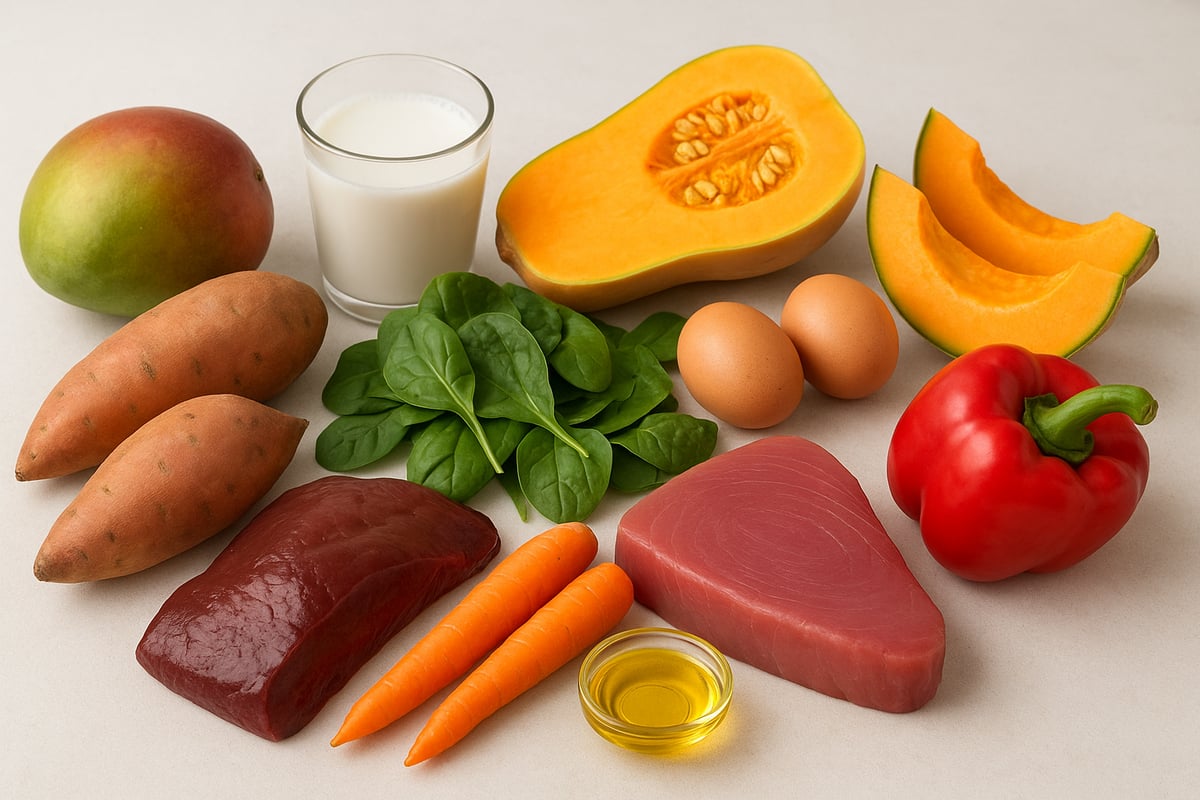
1. Sweet Potatoes
Sweet potatoes are among the top vitamin a foods, with one medium baked sweet potato offering approximately 1,095 mcg of vitamin A, which is 122 percent of the daily value. Their vibrant orange color comes from high beta-carotene content, a powerful plant-based carotenoid that the body converts to vitamin A efficiently when cooked.
Not only are sweet potatoes versatile—perfect for baking, mashing, or roasting—they also provide dietary fiber and antioxidants that support digestive health and immunity. For best absorption, pair sweet potatoes with a healthy fat, such as olive oil or avocado. Including sweet potatoes in your regular rotation of vitamin a foods is a simple, delicious way to boost your daily intake and support eye and immune system health.
2. Beef Liver
Beef liver is one of the most concentrated vitamin a foods available, delivering approximately 6,580 to 7,740 mcg of vitamin A per 3-ounce cooked serving. This equates to more than 700 percent of the daily value, making it a potent choice for quickly replenishing vitamin A stores.
In addition to vitamin A, beef liver provides a rich source of protein, B vitamins, and iron, which are important for energy and red blood cell production. However, due to the risk of vitamin A toxicity from excessive intake, it is best to enjoy beef liver in moderation and as part of a varied diet. When incorporated thoughtfully, beef liver stands out as a nutritional powerhouse among vitamin a foods.
3. Carrots
Carrots are well known as a classic on any list of vitamin a foods. One cup of cooked carrots supplies about 1,330 mcg of vitamin A, or 148 percent of the daily value. Their bright orange hue is thanks to beta-carotene, a key carotenoid that supports vision and immune defenses.
Cooking carrots actually increases the bioavailability of vitamin A, making it easier for your body to absorb. Carrots are easy to include in a variety of meals, from salads and soups to snacks and side dishes. By regularly enjoying carrots, you ensure a steady source of plant-based vitamin A, making them an essential part of your vitamin a foods strategy.
4. Spinach
Spinach is a nutritional powerhouse and a standout among vitamin a foods, with one cup of cooked spinach providing about 943 mcg of vitamin A (105 percent of the daily value). Spinach offers a wealth of carotenoids, as well as iron, vitamin C, and other antioxidants.
This leafy green is low in calories but high in nutrients, making it a smart choice for those watching their weight or seeking to maximize nutrient intake. Spinach can be enjoyed raw in salads, blended into smoothies, or quickly sautéed for a warm side. Including spinach regularly ensures you benefit from one of the most versatile vitamin a foods.
5. Cod Liver Oil
Cod liver oil is a unique entry among vitamin a foods, as just one teaspoon delivers about 1,350 mcg of vitamin A—150 percent of the daily value. In addition, cod liver oil is rich in vitamin D and omega-3 fatty acids, supporting heart, brain, and immune health.
Cod liver oil is typically used as a supplement or drizzled over foods. While it is not suitable for vegans or vegetarians, it remains a valuable option for those seeking a concentrated source of preformed vitamin A. When used responsibly, cod liver oil is a potent addition to your repertoire of vitamin a foods.
6. Butternut Squash
Butternut squash shines as one of the tastiest vitamin a foods, offering approximately 1,140 mcg of vitamin A per cup cooked—127 percent of the daily value. Its sweet, nutty flavor and creamy texture make it a favorite in soups, stews, and roasted dishes.
This winter squash is high in beta-carotene and vitamin C, supporting immune and skin health. Butternut squash is also a good source of dietary fiber, which aids digestion. By incorporating butternut squash into your meals, you add variety and color to your diet while benefiting from one of the most appealing vitamin a foods.
7. Eggs
Eggs are a convenient and accessible source of vitamin a foods, with two large eggs providing about 196 mcg of vitamin A, or 22 percent of the daily value. They contain preformed vitamin A (retinol), which is readily absorbed by the body.
Beyond vitamin A, eggs are rich in protein, choline, and essential amino acids, supporting muscle health and cognitive function. Eggs can be scrambled, boiled, poached, or baked, making them suitable for nearly any meal. Including eggs in your diet helps ensure a steady intake of vitamin a foods, especially for those with busy lifestyles.
8. Tuna (Bluefin)
Bluefin tuna ranks high among vitamin a foods, with a 6-ounce cooked serving providing around 1,287 mcg of vitamin A—143 percent of the daily value. Tuna is also an excellent source of protein and omega-3 fatty acids, which contribute to heart and brain health.
When choosing tuna, opt for sustainably sourced varieties and moderate your intake due to mercury content. Bluefin tuna can be grilled, baked, or added to salads for a protein-rich, vitamin A-boosting meal. As part of a balanced approach to vitamin a foods, tuna offers both nutrition and flavor.
9. Red Bell Peppers
Red bell peppers are a colorful and sweet addition to your vitamin a foods list. One cup of sliced red bell peppers contains approximately 144 mcg of vitamin A, providing 16 percent of the daily value. These peppers are an excellent source of beta-carotene, vitamin C, and dietary fiber.
Their crunchy texture and vibrant color make them a favorite in salads, stir-fries, or as a raw snack. Red bell peppers support eye health and immune function, making them a valuable component of any vitamin a foods-focused diet.
10. Cantaloupe
Cantaloupe is a refreshing fruit that stands out among vitamin a foods, with one cup diced offering about 264 mcg of vitamin A (29 percent of the daily value). Its orange flesh is packed with beta-carotene, vitamin C, and hydration.
Low in calories and naturally sweet, cantaloupe makes an excellent snack or breakfast addition. Its high water content helps with hydration, while the beta-carotene supports vision and immune health. By including cantaloupe, you diversify your intake of vitamin a foods and enjoy a tasty, health-promoting fruit.
11. Fortified Milk
Fortified milk is a reliable and widely available vitamin a foods source, with one cup of nonfat, fortified milk containing about 149 mcg of vitamin A, or 17 percent of the daily value. Many plant-based milk alternatives, such as soy or almond milk, are also fortified to provide similar benefits.
In addition to vitamin A, fortified milk supplies calcium and vitamin D, supporting bone and eye health. It can be used in smoothies, cereals, or as a beverage on its own. Including fortified milk in your daily routine ensures steady access to vitamin a foods, regardless of dietary preference.
12. Mango
Mango is a delicious tropical fruit that rounds out our list of top vitamin a foods. One cup of raw mango provides approximately 89 mcg of vitamin A—10 percent of the daily value. Mangoes are also rich in vitamin C and dietary fiber, promoting digestion and immune support.
Their sweet flavor and juicy texture make mangoes perfect for smoothies, salsas, or desserts. While lower in vitamin A compared to some other foods on this list, mangoes still contribute to your overall intake and offer a flavorful way to enjoy vitamin a foods.
Quick Comparison Table
| Food | Serving Size | Vitamin A (mcg) | % Daily Value |
|---|---|---|---|
| Sweet Potato | 1 medium, baked | 1,095 | 122% |
| Beef Liver | 3 oz, cooked | 6,580–7,740 | 731–860% |
| Carrots | 1 cup, cooked | 1,330 | 148% |
| Spinach | 1 cup, cooked | 943 | 105% |
| Cod Liver Oil | 1 tsp | 1,350 | 150% |
| Butternut Squash | 1 cup, cooked | 1,140 | 127% |
| Eggs | 2 large | 196 | 22% |
| Tuna (Bluefin) | 6 oz, cooked | 1,287 | 143% |
| Red Bell Peppers | 1 cup, sliced | 144 | 16% |
| Cantaloupe | 1 cup, diced | 264 | 29% |
| Fortified Milk | 1 cup | 149 | 17% |
| Mango | 1 cup, raw | 89 | 10% |
By including a variety of these vitamin a foods in your meal planning, you can easily achieve and maintain optimal vitamin A levels. Mix animal and plant-based options, experiment with different recipes, and enjoy the diverse flavors and health benefits these foods provide.
Maximizing Vitamin A Absorption: Cooking, Pairing, and Lifestyle Tips
Unlocking the full benefits of vitamin a foods involves more than just adding them to your plate. The way you prepare, combine, and consume these foods can dramatically influence how much vitamin A your body absorbs. By using strategic cooking methods, smart food pairings, and a balanced approach to eating, you can get the most out of your vitamin a foods and support your overall health.
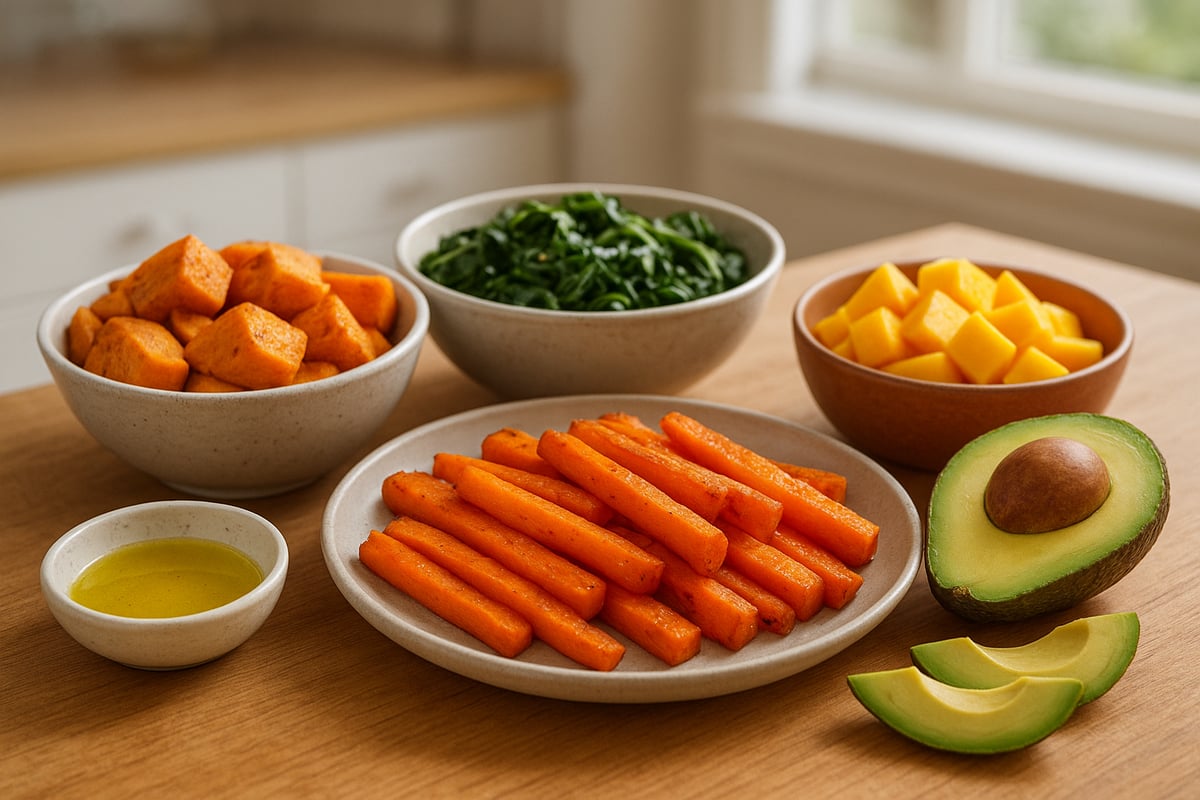
Cooking Methods that Boost Bioavailability
Cooking can significantly enhance the absorption of vitamin A from plant-based sources. Techniques like steaming, roasting, or lightly sautéing break down plant cell walls, making beta-carotene more accessible for your body. For example, cooked carrots and sweet potatoes deliver more usable vitamin A than their raw counterparts.
Steaming is a preferred method, as it preserves more nutrients compared to boiling, which can cause some vitamins to leach into the water. Try pureeing or mashing cooked vegetables to further increase the bioavailability of vitamin A. Incorporating these methods ensures your vitamin a foods provide the maximum benefit.
Pairing with Healthy Fats
Vitamin A is a fat-soluble nutrient, so it requires dietary fat for optimal absorption. Pairing vitamin a foods with healthy fats like olive oil, avocado, or a handful of nuts is a simple way to boost your body’s uptake.
For instance, drizzle olive oil over roasted butternut squash or toss spinach in a salad with slices of avocado. These combinations not only enhance flavor but also help your body make the most of the vitamin A present. Making such pairings a habit can lead to better results from your vitamin a foods.
Balanced Diet and Portion Control
A well-balanced diet that includes a variety of vitamin a foods from both animal and plant sources is key to meeting your nutritional needs. Rotating different foods ensures you also receive other vital nutrients such as fiber, protein, and vitamin C.
It is important to avoid overconsuming concentrated sources like liver or high-dose supplements, as too much vitamin A can be harmful. Practicing portion control and varying your choices will help you maintain safe intake levels. For additional tips on integrating nutrient-rich foods into your daily routine, explore the Wellness Is a Lifestyle Guide.
Addressing Special Diets and Restrictions
People following special diets, such as vegetarians or vegans, can still meet their needs by focusing on plant-based vitamin a foods and fortified products. Options like carrots, sweet potatoes, spinach, and fortified plant milks are excellent choices.
If you have allergies or intolerances to common vitamin a foods like eggs or dairy, look for alternatives that fit your requirements. Always read labels to check for fortification and consult with a healthcare provider if you have specific dietary restrictions. Adapting your approach ensures everyone can benefit from vitamin a foods, regardless of dietary needs.
Frequently Asked Questions About Vitamin A Foods
Navigating the world of vitamin a foods can lead to many questions about safety, effectiveness, and how to get the most from your diet. Here, we address the most common concerns with evidence-based answers, helping you make the best choices for your health.
Can I Get Too Much Vitamin A from Food?
Most people eating a balanced diet of vitamin a foods do not experience toxicity. The real concern comes from large amounts of animal-based sources or supplements, which deliver preformed vitamin A (retinol) that is immediately absorbed. Plant foods, rich in carotenoids, pose little risk because the body only converts what it needs. Symptoms of too much vitamin A include headache, nausea, and potential liver damage.
It is important to know your limits. According to the Dietary Reference Intakes for Vitamin A, the safe upper intake level for adults is 3,000 mcg per day. Staying within this range is easy if you focus on a variety of vitamin a foods and avoid high-dose supplements or frequent liver consumption.
Are Supplements Necessary?
For most healthy adults, a well-rounded diet featuring vitamin a foods is sufficient to meet daily needs. Supplements are rarely needed unless a healthcare provider identifies a deficiency or a medical condition that affects absorption. Over-supplementation can lead to toxicity, which is why food-first is the safest approach.
If you are considering supplements, always consult with your physician before starting. Remember, vitamin a foods provide additional nutrients and fiber that supplements cannot match. Prioritize dietary sources for balanced nutrition.
What’s the Difference Between Retinol and Beta-Carotene?
Vitamin a foods deliver two main forms: retinol and beta-carotene. Retinol is found in animal products and is readily used by the body, while beta-carotene, found in colorful fruits and vegetables, must be converted before it is active. This conversion process is efficient for most people but can vary based on genetics and overall health.
Retinol can accumulate and cause toxicity if consumed in excess, especially from supplements. Beta-carotene is considered safer since the body regulates its conversion. For a deeper look at the benefits and potential risks, see Vitamin A: too good to be bad?. Including both sources in your vitamin a foods intake supports a balanced approach.
How Can I Tell if I’m Deficient?
Deficiency in vitamin a foods shows up as night vision problems, frequent infections, and dry or rough skin. Those at higher risk include people with malabsorption disorders, vegans, or older adults. If you notice these symptoms or belong to an at-risk group, seek medical advice for testing and tailored guidance.
Exploring the best vitamin A foods is a smart way to invest in your health, especially as we look ahead to 2025 and beyond. You have seen how whole, plant-based options can support your vision, immune system, and overall wellbeing, and how making small changes in your daily meals adds up over time. If you are ready to take the next step toward a more vibrant, balanced life, I invite you to discover the carefully crafted, clean supplements and natural skincare at Essential Life. Prioritize your wellbeing, inside and out—Shop Now to see how nature can help you thrive.
